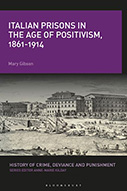Italian Prisons in the Age of Positivism, 1861-1914

Author: G. Geltner
Publisher: Bloomsbury, 2021. 320p.
Reviewer: Mary Gibson ǀ June 2022
Italy’s initial unification as a parliamentary monarchy in 1861 precipitated dramatic changes, including in the sphere of criminal law and justice. The young nation’s identity was bound, as elsewhere across Europe, with a set of new liberal norms, and institutions to enforce them, which both practically and symbolically reacted to the ills of the old regime. Yet both policy and practice had to be negotiated among numerous stakeholders, including politicians on the liberal Right and Left, legal and medical scientists, an increasingly free press, a transitioning judiciary, feminist and labor activists and a nascent national executive branch scrambling for power with limited means and often dilapidated material infrastructures. Virtually all of these parties were quickly learning how to operate in a more vast and more complex public sphere, albeit one still strongly encumbered by regional traditions shaped over many centuries.
No stakeholder or even alliance, as Mary Gibson’s lucid and broad-ranging book demonstrates, triggered a linear process of reform when it came to state-sanctioned punishment. That is, contrary to the normative process of state-formation expounded by Marx, Weber and Foucault, among others, the formation of Italy as a modern polity did not birth the modern prison. Nor, moreover, was that somehow a failure of the state or an anomaly among general processes of modernization. Instead, as Gibson describes in rich detail, and on the basis of a range of newspaper reports, institutional archives, legal commentary, ego-documents and statistical data, abundant contingencies were involved in this rather normal process of state formation, including the internal contradictions it shored up.
There were, to be sure, peninsular peculiarities to this process. Chapter 1 provides a major key to understanding these, by sketching the deeper past of Rome’s penal landscape, which reflects constant tensions between secular-municipal and ecclesiastical powers. In concrete ways, and well beyond Rome, it was this legacy that late nineteenth-century reformers had to contend with, as elaborated in chapters 2 and 3 and illustrated throughout chapters 4-7, which deal respectively with institutions for women, men and juveniles. Gibson’s delving into the medieval and especially early modern history of Roman (and several other) prisons is particularly commendable as it is rare among modernists, and proves especially productive for understanding the pitfalls of later reforms.
Secondly and relatedly, unlike its better-studied northern European and US counterparts, Italy was predominantly Catholic. Local infrastructures of charity as well as entrenched attitudes towards children and especially women, had lasting effects on the latter’s marginalization within penal and corrective institutions’ overall project of nation building, which mainly targeted men as new citizens. Gibson argues (chapter 4 and passim) that leaving women and girls mostly in the hands of nuns cannot simply be ascribed to their statistical minority, and instead illuminates a uniquely Italian amalgamation of private and public punishment, which overall kept women beyond the pale of reform. On the other hand, their marginalization allowed women to obviate some of the harsher regimes that reforms could spawn.
Next, shaping the Italian penal landscape at the time was the powerful positivist school of criminology, led by the Turin-based physician Cesare Lombroso, whose adherents included medical scientists, jurists, parliamentarians and administrators of prisons and asylums for the criminally insane (the focus of chapters 7 and 8). Gibson, a world-class expert on Lombroso, argues that here too the school’s legacy, including into the Fascist Era, was complex. On the one hand, it reinforced a sexist, classist, ethnocentric and racist approach to criminality by generating data from the penal institutions it inspired and ran, and which increased its erstwhile international prestige. On the other, positivism was instrumental in phasing out corporal punishment, curbing police and judicial power, and mainstreaming ideals of tailor-made rehabilitation, programming and mental treatment, above all in male institutions (chapter 5), which was a welcome corrective to the ideals of the first major wave of prison reform in northern Europe and the US.
A final trait of the Italian criminal justice system in this era was its exacerbation (and perhaps even crystallization) of the country’s major socio-economic and cultural divide between the wealthy, urbanized and industrialized north and the impoverished, depopulated rural south. As Gibson repeatedly notes, the positivist criminalization of southern men and women created a pseudo-scientific platform for promoting a national identity based on northern cultural norms. In a classic self-perpetuating cycle, southern inmates were over-represented across the peninsula’s prison population, and as such supplied fodder for the ethnocentric gathering and analysis of data and assembling of “criminal artefacts,” such as graffiti, poetry and clay vessels, produced by often southern prison inmates into museums by northern criminologists and administrators.
A great strength of this book is its repeated demonstration of the value of comparative synchronic and diachronic perspectives. Without tracing the era’s prisons and reformatories for women and children, as well as marginal institutions such as police camps and insane asylums (chapter 7), for instance, the achievements of “mainstream” male institutions would be far easier to over- (and sometimes under-) state. The volume likewise under-promises and over-delivers when it comes to its chronological scope, which professes to treat the period 1861-1914, but in fact ably covers the early modern period and regularly traces institutions’ interwar, Fascist and even later phases. Such broader contexts are crucial for comprehending what in fact is being chronicled at the book’s chronological heart. Last but not least, Gibson helpfully situates her findings, which are accompanied by an appropriate number of graphs and illustrations, within a broader European and global context of penal institutions and reforms, and the particular impact of colonialism and imperialism.
There is, in sum, much to recommend about Gibson’s masterful account of a young Italy’s ongoing attempts to reform its penal system. The focus on Roman prisons as semaphores of a national scene, including their pre-national phases, may have been a useful strategic choice. Yet it also involves a certain teleology of nation-building with Rome at its center. After all, papal Rome was for centuries a rather untypical hybrid city, while numerous secular and ecclesiastical prisons, sometimes purpose-built, from Palermo to Florence to Venice, operated with little interruption (and are occasionally well documented) since at least the early fourteenth century, and could have served as equally, if not more, incisive case studies in a regional portrait. None of this, however, is to detract from the value of Gibson’s sobering and eminently readable book, which offers a far more grounded account of the entanglement of nation-building and penal reform than any narrative invested in uncovering the birth of the prison.
Guy Geltner is a Professor of History in the Faculty of Arts at Monash University


